A theoretical paper claims that atmospheric metal contamination from defunct satellites could create an invisible shield around our planet that could weaken its magnetic field.
The controversial new paper was written by Seattle-based scientist Sierra Solter-Hunt, and has not yet been peer reviewed.
It claims that falling space debris may well weaken our magnetosphere, but some experts are skeptical.
It cites specific satellite ‘mega-constellations’ like SpaceX’s Starlink network, which can generate enough magnetic dust to cut our planet’s protective shield in half, writes Solter-Hunt.
In the worst-case scenario, the so-called ‘spacecraft dust’ could lead to satellite disasters as well as ‘atmospheric stripping,’ the author told Live Science – a phenomenon where increased levels of radiation could begin to blow away the outer edges of our atmosphere.

The paper cites specific satellite ‘mega-constellations’ such as SpaceX’s Starlink network, which could allegedly generate enough magnetic dust to cut our planet’s protective shield in half. Pictured: A Starlink satellite orbiting the Earth
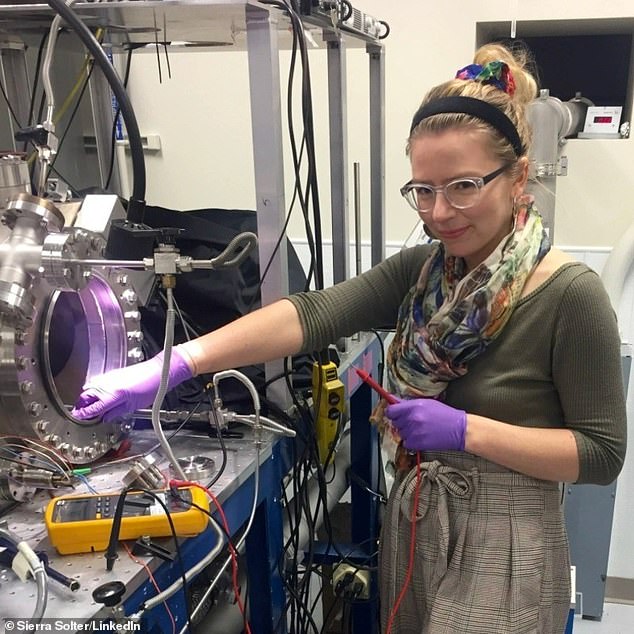

The paper was written by Seattle-based scientist Sierra Solter-Hunt (pictured), and has not yet been peer reviewed. She believes the floating space junk is likely to settle in the upper part of the ionosphere — about 50 to 400 miles above Earth’s surface — and weaken its magnetic field
It has already occurred naturally on planets like Mars and Mercury, the paper points out, making them particularly uninhabitable.
“I was shocked by everything I found and that no one has studied this,” Solter-Hunt said Live Science Monday of her finding.
‘I think it’s really, really alarming.’
In his paper, the astrodynamicist continues that somewhere between 500,000 and 1 million private satellites could be orbiting our planet in the coming decades — a big jump considering the 9,494 active satellites listed as currently orbiting Earth.
It comes as companies like Elon Musk’s SpaceX are also expanding secret satellite programs like the Pentagon’s Starshield, which is currently used by the federal government.
A Space Force spokesman confirmed in September that SpaceX was awarded a one-year contract for Starshield with a maximum value of $70 million as it quietly forges deeper ties with US intelligence and military agencies.
Meanwhile, satellites from SpaceX’s Starlink network can already be seen orbiting Earth, interfering with radio telescopes and obscuring cosmic images being captured by astronomers.
Private satellites also pose other problems, such as the potential for collision with other spacecraft — although, Solter-Hunt says, the biggest concern comes when they stop working.
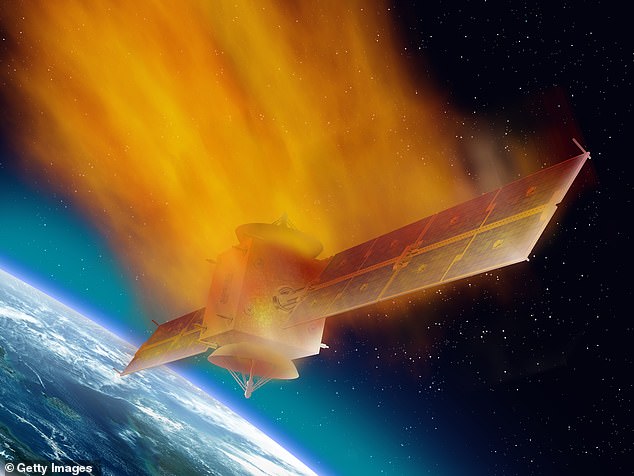

The paper claims that falling space debris from burnt-out satellites may well weaken our magnetosphere as the number of privately owned craft continues to rise
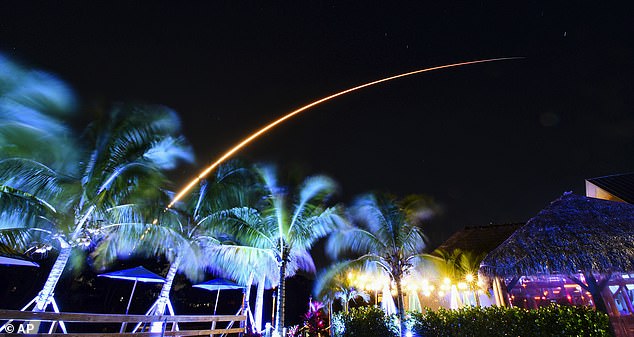

Pictured: SpaceX Falcon 9 carrying Starlink satellites on January 28. Starlink has proven a lifeline for Ukrainian forces fighting the Russian invasion of Eastern Europe


A SpaceX rocket carrying 23 Starlink satellites lifts off from Kennedy Space Center on January 28
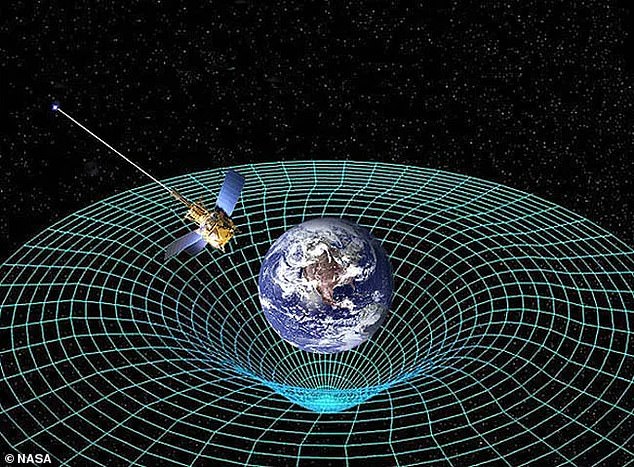

Pictured: A graphic artist’s impression of the effect Earth’s gravity has on spacetime
When that happens, satellites in low orbits at an altitude of a few hundred miles from Earth or lower will enter the atmosphere and burn up in a time frame ranging from several years to decades – while satellites in higher orbits would not come down for more than 100 years.
When these satellites eventually fall to Earth, it could increase the amount of spacecraft dust in the atmosphere to billions of times its current level, Solter-Hunt warns — adding at one point, “And it could just stay there forever.”
She believes the floating space debris is likely to settle in the upper part of the ionosphere — about 50 to 400 miles above the Earth’s surface.
This is where the physicist fears metal contamination will cause problems, creating a ‘perfectly conductive web around our planet’ potentially capable of carrying an electrical charge,’ she writes.
In the event of such an event, the magnetosphere, which normally extends thousands of miles into space, can be “distorted to become below the conductive material”, reducing its reach into the upper ionosphere,
It about 300 to 400 miles above the Earth’s surface, right at the edge of space.
A reduced magnetic field means these satellites could thus be exposed to higher levels of radiation and even solar storms, which could knock them out of the sky, warns Solter-Hunt.
“They could weaken the magnetosphere with what they’re doing,” she goes on to add, which, she said, “puts (satellite companies) at risk.”
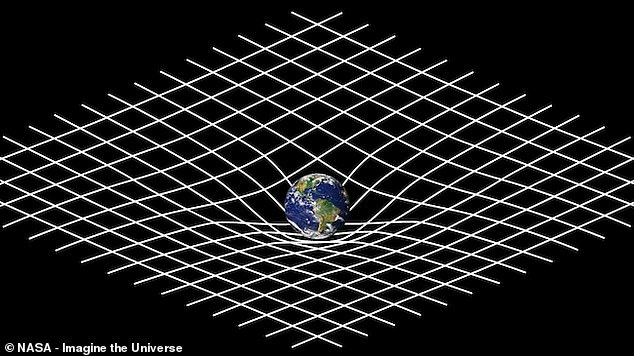

The image: Illustration of how space-time curves in the presence of a massive object – in this case the Earth
“It’s a real Catch-22 for satellite companies,” she adds.
But even if the increased levels of radiation could strip our atmosphere, rest assured — Solter-Hunt says it would still likely take centuries, if not millennia, to occur.
Still, not all scientists agree — with John Tarduno, a planetary scientist and magnetosphere expert at the University of Rochester in New York, responding to his contemporary’s claims in a strongly worded email.
“Even at the discussed densities (of spacecraft dust), a continuous conducting shell like a true magnetic shield is unlikely,” he told LiveScience on Wednesday.
He added that some of the conclusions Solter-Hunt jumped to are “too simplistic and improbable to be correct” — a sentiment echoed by at least other experienced researchers who spoke to the publication.
José Ferreira, a doctoral candidate at the University of Southern California, told LiveScience that no one has ever modeled how spacecraft dust will settle in the atmosphere, so there is no precedent or proof that magnetic shielding is even possible.
The space dust pollution expert’s opinion was raised by a researcher at England’s Durham University who specializes in space ethics, who also told LiveScience that the scenarios set forth by Solter-Hunt are too speculative.
The paper is an “interesting thought experiment,” Fionagh Thompson said, but without clearly outlining exactly how spacecraft dust will cause these problems, “it shouldn’t be disseminated because ‘that’s what’s going to happen,'” she said.
She went on to add that the number of potential satellites orbiting Earth in the future estimated by Solter-Hunt also ‘seems exaggerated’, citing how many touted satellite launches never occur.
“This is not a problem to be ignored, (and)

